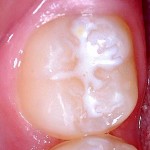
The recent Cochrane review update by Ahovuo-Saloranta et al (Dental Elf – 31st Jul 2017) reaffirmed the effectiveness of fissure sealants for the prevention of occlusal caries in the permanent molars of children and adolescents. However, the authors noted that there was very low-quality evidence for the relative effectiveness of different types of sealant.
The aim of this review was to evaluate the retention of flowable composite used as fissure sealants compared with conventional resin-based sealants.
Methods
Searches were conducted in the PubMed, SCOPUS. Embase, Cochrane Database of Systematic Reviews, and ISI Web of Knowledge (All Database: Web of Science Core Collection, Current Contents Connect, Data Citation Index, Derwent Innovations Index, KCI Korean Journal Database, MEDLINE, Russian Science Citation Index, SciELO Citation Index) databases. Two reviewers independently selected studies and assessed risk of bias using a modified Jadad scale. Controlled clinical studies evaluating a flowable resin composite as a fissure sealant material on permanent teeth were considered with only randomised controlled trials (RCTs) with a follow up of longer than 12 months being included in the meta-analysis.
Results
- 11 studies were included
- 4 were considered to have a low risk of bias, 7 a medium risk of bias.
- Meta-analysis of sealant retention found higher odds of retention for flowable composites
- Odds ratio = 2.387 (95%CI; 1.047-5.444) P = 0.039.
- Risk difference = 0.093 (95%CI; 0.004 – 0.182) P = 0.04.
Conclusions
The authors concluded: –
It seems that the use of flowable composite as a fissure sealing material can slightly increase the retention rate of sealants compared with conventional resin-based sealants.
Comments
The authors have used a broad search strategy to identify appropriate papers for inclusion in this review. They have chosen to use a modified version of the Jadad scale to assess the risk of bias in the included studies. This type of scoring system in no longer recommended and the more widely used and Cochrane risk of bias tool would have been a more appropriate tool to use. Consequently, the risk of bias assessment used in this review is likely to have been overly generous given that the authors themselves only indicate that appropriate randomisation was only used in 2 studies. This has implications for consideration of the findings in particular because of the wide confidence intervals for the odds ratio and the fact that the lower limit is close to the line of no effect, as is the risk difference.
While the Cochrane review focused on caries reduction as its primary outcome it also reported on retention with 38 of the included trials reporting retention data; with 90% retention at 12 months, and 80% at 24 months with 70% after 48-54 months.
Links
Primary Paper
Bagherian A, Shiraz AS. Flowable composite as fissure sealing material? A systematic review and meta-analysis. Br Dent J. 2018 Jan 26;224(2):92-97. doi: 10.1038/sj.bdj.2018.40. PubMed PMID:29372708.
Other references
Dental Elf – 31st Jul 2017

[…] post Fissure sealing using flowable composite appeared first on National Elf […]